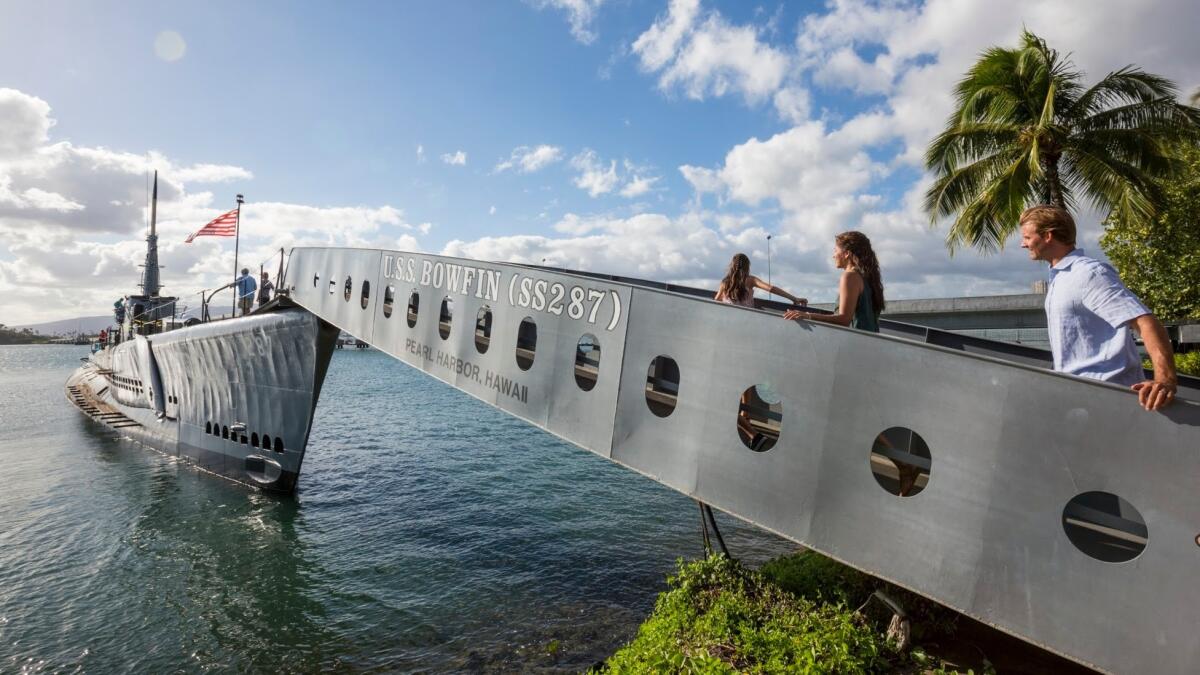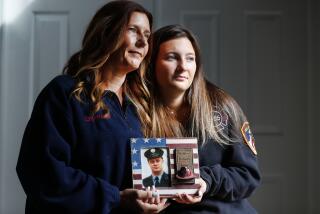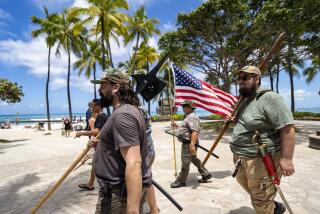The Pearl Harbor attack is still seared into a survivor’s memory: ‘Everything ... blew up and was on fire’
- Share via
President Franklin Roosevelt described it as “a date which will live in infamy.” As the 75th anniversary of the attack on Pearl Harbor approaches, sailors and civilians have worked to spruce up Hawaii’s biggest tourist attraction.
Visitors from around the world, including many Japanese, come visit every day but Thanksgiving, Christmas and New Year’s Day. They take the short boat ride from a pier beside the Pearl Harbor Visitor Center to the USS Arizona Memorial, which floats above the sunken battleship. The images of the sinking ship, ablaze after being bombed by enemy warplanes, are etched into the American psyche.
Of the more than 2,400 service members and civilians killed that Sunday morning, nearly half the total – 1,177 – were sailors and Marines aboard the Arizona.
“There were 335 [sic] of us on the ship that got off that day,” Lou Conter, one of those survivors, told me as we stood on the memorial. “We were just lucky.”
Conter, now 95 and one of only five survivors still alive, makes a pilgrimage from his Grass Valley, Calif., home to Honolulu each Dec. 7 to stand aboard the Arizona Memorial as wreaths are laid to remember those who died.
He plans to travel across the Pacific again this month. Three of his comrades also hope to attend a morning observance on Kilo Pier (it’s open to the public) before traveling to the memorial.
Despite the passing decades, Conter’s memories of that day are clear.
“I was on the quarterdeck, just about where we are,” he recalled. “Everything from right over there forward blew up and was on fire.”
More than 1,300 free tickets are distributed each day – on a first come, first served basis – for the shuttle operated by Navy sailors. The USS Arizona Memorial is the centerpiece, but it is just one of several attractions at the World War II Valor in the Pacific National Monument, about 13 miles northwest of the Waikiki hotels.
Usually guests can see the free attractions in about 90 minutes. There is a wealth of informative exhibits at the Visitor Center, where a 23-minute documentary is screened throughout the day.
Two other attractions are moored here, but you’ll have to pay to visit the USS Bowfin and the USS Missouri, neither of which was built at the time of the attack.

The Bowfin, an attack submarine, was launched one year to the day after the Japanese air raid. Between 1943 and 1945, the sub spent most of its patrols in the South China Sea. Self-guided tours of the ship and an adjacent museum cost $12 for adults and $5 for children 4-12. Headsets for an audio tour are included.
Although it wasn’t built until 1944, the USS Missouri, often called the “Mighty Mo” played a historic role in the war. While at anchor in Toyko Bay, the Japanese formally surrendered aboard the ship on Sept. 12, 1945.
A brass plaque marks the spot where Gen. Douglas MacArthur signed the document on behalf of the Allies, officially bringing the war to an end.
Because it’s on Ford Island, still an active military base, visitors are taken to the Missouri (and the nearby USS Oklahoma monument) aboard buses that depart regularly from the visitor center. Tickets cost $27 for adults and $13 for children 4-12.
The attack’s aftermath is also being remembered in “Homefront Hawaii,” a special exhibit at Honolulu’s Bishop Museum. The displays share the stories of ordinary citizens and what they had to endure in the days, weeks and years after Dec. 7, 1941.
Japanese-Americans, who many feared might be aiding the enemy, were required to register and community leaders were arrested and interned in camps in Hawaii and on the U.S. mainland.
One of the curious artifacts is a $10 bill with the word “Hawaii” in large letters over an image of the U.S. Treasury building. The special money, circulated only in Hawaii, was printed because of the ongoing fear of an invasion.
The Japanese could have seized large amounts of the money, but they would not have been able use it to disrupt America’s economy, because it wasn’t good outside of the islands.
The exhibit is open and continues through February.
ALSO
Will San Francisco gain a new landmark? Old U.S. Mint receives funds for a face-lift plan
Hike and explore Utah’s ‘Mighty 5’ national parks on this 10-day tour
No one vacations in Hawaii to pick fruit. A new chef-led tour changes that
More to Read
Sign up for The Wild
We’ll help you find the best places to hike, bike and run, as well as the perfect silent spots for meditation and yoga.
You may occasionally receive promotional content from the Los Angeles Times.






